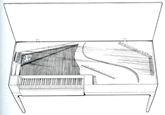The clavichord had its heyday before the breakthrough of pianos around 1800. Here in Sweden, however, we differed from the rest of Europe in that our clavichord culture was alive in certain circles until around 1870. This was because we developed our very own clavichord model, which was designed to endure the Swedish climate which is unfavourable for musical instruments and at the same time be a full-fledged musical instrument.
The clavichord has its origins in antiquity, when the intervals (distances between two notes) were discovered by stringing up a string and using moveable staves to divide it according to mathematical models. The monochord (“single string”) was thus a instrument of Physicists, a function that it retained into our time (see Monochord under Special instruments). During the High Middle Ages, the monochord acquired more strings and thereby became a polychord (“multi-strings”), which then acquired a keyboard and became the clavichord (“keyed strings”).
At its simplest level of construction, the key is a lever, which at each end has the player’s finger and a tangent that strikes the string (as well as determining its sounding length), so that the note sounds as long as the finger remains on the key and can even be affected after the strike in a vibrato. This string contact made the clavichord the basic instrument one had to master in order to play the organ and other stringed keyboard instruments well. Therefore, the clavichord was especially used as the organist’s practice instrument, which was not infrequently equipped with a pedal.
There were two types of stringing plans used for the clavichord, the older fretted, where several notes share one string, and the unfretted, where each note has its own string. Fabric “listing” is woven through the strings beyond the tangent, so that only the desired half of the string sounds. This design did not leave room for any major experimentation when it came to the shape, which is a rectangular box, albeit of many sizes. Around 1720 came the only known variant, the organ builder Gottfried Silbermann’s cembal d’amour, where the pins divide the string exactly in half, and allow both halves of the string to sound.
You can read more about the clavichord in the Little Keyboard History in our Knowledge Bank.



